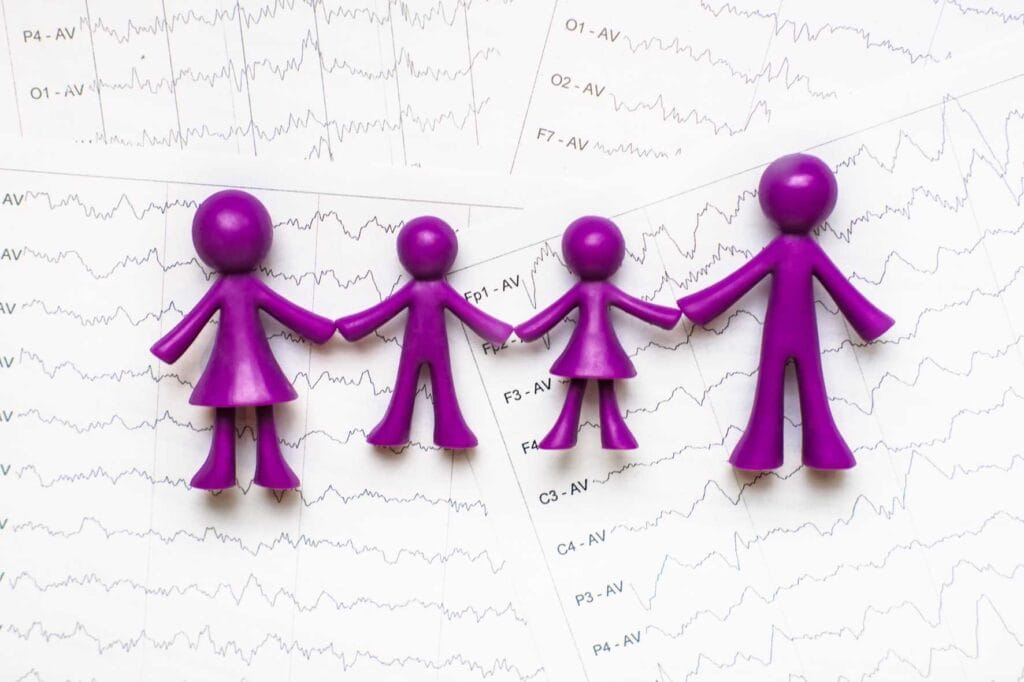Epilepsy is more than just a seizure; it profoundly affects the quality of life for millions worldwide. As a chronic neurological disorder, epilepsy impacts approximately 50 million people globally and is characterized by abnormal electrical activity in the brain. Despite being one of the earliest known medical conditions, with historical references dating back to 4000 BC, misconceptions and stigma continue to create challenges for those affected.
- What Living With Epilepsy May Feel Like? Understanding The Hidden Social Impact
- What is Epilepsy? Understanding This Neurological Disorder
- Who Is At Risk? Risk Factors Explained
- Symptoms & Diagnosis: How to Identify the Signs?
- How to Treat: Medication, Surgery & Lifestyle Changes
- What Is Beyond Seizures? The Emotional & Social Impact
- Breaking the Stigma: What Should Be Our Approach Towards a Meaningful Change?
- Conclusion: Take Action And Do Your Part
What Living With Epilepsy May Feel Like? Understanding The Hidden Social Impact

It is a complex neurological disorder that extends beyond medical implications; it can significantly alter the social status of those affected. This condition leads to a range of physical, emotional, and social consequences.
- Marriage & Social Stigma: Many people with epilepsy (PWE) often hide their condition during marriage negotiations due to frequent rejection and social discrimination.
- Lack of Awareness in Schools: A study across 27 countries revealed that school teachers had misconceptions and negative attitudes towards this disorder, further reinforcing stigma and misinformation.
Understanding these challenges is key to breaking the cycle of discrimination and fostering an inclusive society.
What is Epilepsy? Understanding This Neurological Disorder

Epilepsy is a non-communicable neurological condition that leads to recurring seizures, abnormal brain activity, and in some cases, unusual behaviours or sensory experiences including occasional loss of consciousness.
Despite its prevalence, epilepsy remains widely misunderstood, leading to delayed diagnosis, stigma, and lack of access to treatment.
Key Facts About Epilepsy:
- Affects all age groups – men, women, and children.
- 70% of cases can be controlled with proper diagnosis and treatment.
- 80% of epilepsy cases occur in low- and middle-income countries where treatment access is limited.
- The exact cause remains unknown, but genetics, infections, and brain injuries are contributing factors.
People with epilepsy may have an array of symptoms, ranging from most chronic which is losing awareness to as subtle as being unable to answer simple questions.
Who Is At Risk? Risk Factors Explained

Epilepsy knows no boundaries; it affects men and women across various races, ethnicities, and age groups. However Common Risks for the development of the same may include:
- Brain injuries (Traumatic brain injury, stroke)
- Genetic disorders & family history
- Infections (Meningitis, Encephalitis, Neurocysticercosis)
- Brain tumours
- Neurological conditions (Alzheimer’s, Autism)
- Severe prenatal & birth complications
Symptoms & Diagnosis: How to Identify the Signs?

What Are The Symptoms Of Epilepsy?
Epileptic seizures are generally classified into four types: generalised, focal, combined, and unknown.
Their severity can vary significantly, with some individuals experiencing mild episodes that affect only one or two body parts, while others may have seizures that involve the entire body.
These differences can be influenced by factors such as nervous system dysfunction, the specific areas of the brain involved, triggers, and past trauma. While seizures are usually linked with apparent symptoms, some people may have them without any visible or typical signs.
However, the muscular movements during a seizure can further be categorised into four main types:
- Tonic Seizures – Muscles become stiff.
- Atonic Seizures – Sudden loss of muscle power or tone.
- Myoclonic Seizures – Brief, quick jerking movements.
- Clonic Seizures – Rhythmic or periodic shaking or jerking.
However, as mentioned, seizures can affect a single part of the body (focal seizures) or the entire body (generalized seizures).

How is Epilepsy Diagnosed?
A comprehensive clinical examination may be sufficient for a diagnosis in certain cases. However, there are instances where additional diagnostic tests as listed below are necessary for definitive diagnosis.
- Electroencephalography (EEG)
- Magnetic Resonance Imaging (MRI)
- Positron Emission Tomography (PET) scans
- Blood Tests
- Neurological Exams
Early diagnosis is crucial for effective treatment. If one suspects epilepsy, consult a healthcare professional immediately which may significantly impact the individual’s quality of life.
How to Treat: Medication, Surgery & Lifestyle Changes

Pharmacological Treatment: Medication continues to be the most often utilised treatment, modern medicine encompasses a variety of approaches, including Anti-seizure medications (ASMs), neurostimulation devices, and cannabidiol (CBD).
Surgical Management: For drug-resistant epilepsy, newer surgical treatments include:
- Laser Interstitial Thermal Therapy (LITT)
- Responsive Neurostimulation
- Deep Brain Stimulation (DBS)
- Vagus Nerve Stimulation (VNS)
However, it is important to note that not all epilepsy patients qualify for surgery, highlighting the significance of advancement for medical treatment innovation.
Non-Pharmacological Therapies: In addition to traditional medical approaches, non-pharmacological therapies are gaining recognition in epilepsy management.
- Ketogenic Diet: High-fat, low-carbohydrate diet is known to reduce seizures in some patients, particularly among pediatric patients
However, concerns about the long-term safety and effectiveness concerns of these routes remain and it is generally not recommended for adults.
What Is Beyond Seizures? The Emotional & Social Impact

Epilepsy is a chronic disorder that has physical, emotional, and social implications. Approximately 80% of epilepsy treatment in developing nations is inadequate. This is due to a variety of factors, including fear of stigma, cultural beliefs, a lack of knowledge, and due to economic disadvantage.
Mental Health & Epilepsy: Psychological challenges
The interplay between epilepsy and mental health is complex which leads to mood disorders such as anxiety and depression. This imposes an impact on not just the individuals but their family members as well.
PWE frequently has a history of mood or anxiety disorders, as well as other psychiatric illnesses, prior to the development of epilepsy. As a result, it is critical to include patients’ entire psychiatric history during the diagnosing process.
In addition to PWE acquiring psychiatric disorders, current research has shown that individuals with a history of depression, anxiety, or attention deficit disorder are also at risk of developing epilepsy.
This risk is four-fold higher than the general population if the individual has a history of suicidal tendencies or behaviour and 3.5 fold higher than a person with a history of attention deficit disorder of the inattentive type.
Public awareness and better support systems are necessary to reduce mental health burdens on epilepsy patients.
Cultural Beliefs & Stigma: Social & Economic Challenges

One of the major challenges that are imposed by the condition is the existence of misconceptions and myths about epilepsy contributing to the societal stigma.
In India, epilepsy is frequently related to supernatural beliefs or moral flaws. As a result, the individual having epilepsy experiences fear and avoidance. It is commonly considered a mental ailment or a curse, especially in rural communities.
As a result, there is a reluctance to seek proper care in a timely manner, which is caused by stigma and a lack of information about the illness.
Access to proper healthcare is another major hurdle, especially for those in rural or economically disadvantaged areas. Many people may find themselves without the resources needed for effective diagnosis and treatment.
Hence, Breaking the stigma through information and education is essential.
Breaking the Stigma: What Should Be Our Approach Towards a Meaningful Change?

Collaborative Approaches: Individuals with this disorder face a unique array of social and medical challenges that can significantly impact their quality of life. While many can lead fulfilling lives, they often encounter a series of obstacles and distinctive experiences on their journey.
Each person’s story is different, revealing the struggles they have faced and the resilience they have demonstrated. These personal narratives not only highlight the strength of individuals living with epilepsy but also accentuate the vital role of a supportive community in empowering them to overcome social barriers.
Family Care: Stigma surrounding epilepsy often begins at home, where misinformation and fear can lead to the isolation of those affected. Families are instrumental in creating a nurturing environment that fosters understanding and acceptance.
To ensure that families can effectively support their loved ones, incorporating counseling into formal epilepsy care is essential. This approach can equip families with the knowledge and resources needed to combat stigma, enhance communication, and promote a more positive outlook on living with epilepsy.
Public health approach: There is a need for public health awareness programs and research tailored to the Indian context, focusing on genetics, infections, and cultural factors that influence care and outcomes for individuals with epilepsy. Such initiatives can help improve understanding and reduce stigma, ultimately enhancing the quality of life for those affected by the condition.
Conclusion: Take Action And Do Your Part
Epilepsy is a chronic disorder with far-reaching implications. Approximately 80% of treatment in developing nations is inadequate, largely due to stigma and a lack of education.
By fostering understanding and compassion, we can create a more supportive environment for individuals living with epilepsy and work toward better healthcare solutions.
Share this article with someone in need to help change the narrative. Together, we can create a world where epilepsy is understood, accepted, and properly treated.
Additionally, If You Want To Learn about another neurological disorder ADHD, and want to learn about simple yet effective strategies to navigate the same, read the article by clicking here.
Written By: CPH Editorial Team
Medically Reviewed By: Dr Ananya Adhikari





Nice blog.
Thank you! We’re glad you found the blog informative!